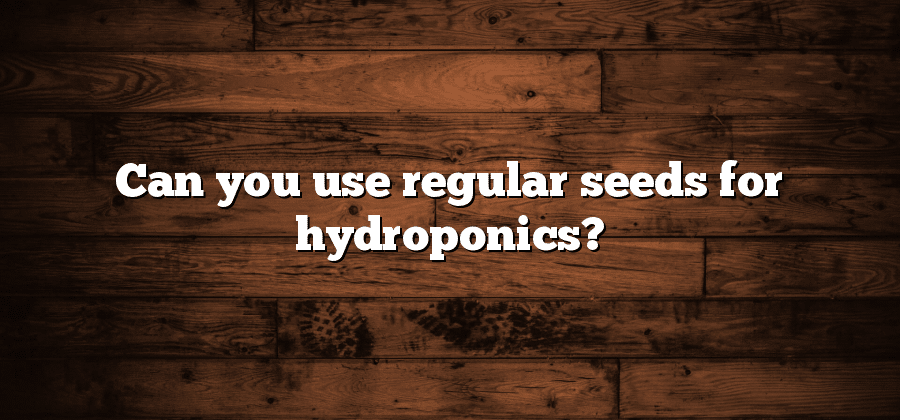Germination Process: Techniques for Successful Seed Sprouting in Hydroponics
Hydroponics, a method of growing plants without soil, has gained popularity among gardening enthusiasts due to its efficiency and effectiveness. When it comes to germinating seeds in hydroponics, following the right techniques is crucial for successful seed sprouting. Here are a few key strategies to consider.
Firstly, proper moisture levels are essential for seed germination. Ensure that the growing medium is moist, but not overly saturated, as excess water can suffocate the seeds. Maintaining a consistent moisture level throughout the germination process is crucial to prevent seed drying or drowning.
Secondly, providing the correct temperature is vital for seed sprouting. Most seeds require temperatures between 65°F and 75°F (18°C and 24°C) for optimal germination. Investing in a temperature-controlled environment or using heating mats can help create the ideal conditions for seed sprouting in hydroponics.
By implementing these techniques, you can enhance the germination process and increase the chances of successful seed sprouting in hydroponics. Remember to monitor the moisture levels and temperature regularly to ensure the seeds have the best environment for their growth and development.
Nutrient Solution: Adjusting the Formula for Regular Seeds in Hydroponic Systems
When it comes to adjusting the nutrient formula for regular seeds in hydroponic systems, precision is key. Providing the right balance of nutrients at each stage of growth is essential for healthy sprouting and subsequent development. However, it is important to note that the nutrient requirements may vary depending on the specific type of regular seed being cultivated.
To begin, it is crucial to understand the macro and micronutrients that regular seeds need for optimal growth. These include essential elements like nitrogen, phosphorus, potassium, calcium, magnesium, and sulfur, along with a range of micronutrients such as iron, manganese, zinc, and copper. Adjusting the nutrient formula involves carefully measuring and adjusting the quantities of these elements in the hydroponic solution. Properly calibrated nutrient formulas will ensure that regular seeds receive all the necessary elements in the right proportions, creating an environment conducive to robust growth.
Transplanting Regular Seeds: How to Ensure a Smooth Transfer into Hydroponic Setups
In hydroponic gardening, the success of transplanting regular seeds into the setup largely depends on a few key factors. Firstly, it is essential to choose the appropriate timing for transplanting. The seedlings should be at the right stage, with well-developed roots and leaves, ensuring they can withstand the transition into a hydroponic environment. Transplanting too early can result in shock or stunted growth, while transplanting too late may lead to root overcrowding.
Additionally, proper preparation of the hydroponic setup is crucial for a smooth transfer of regular seeds. Prior to transplantation, ensure that the pH and nutrient levels of the water are adjusted according to the specific needs of the plant species. This will help maintain an ideal growing environment and allow the roots to establish themselves more effectively. Furthermore, it is important to thoroughly clean and disinfect all equipment and containers to prevent the introduction of pests and diseases that could harm the delicate seedlings. By following these steps, gardeners can ensure a seamless transition and promote the healthy growth and development of regular seeds in a hydroponic setup.
Growth and Development: Monitoring Regular Seed Progress in a Hydroponic Environment
Monitoring the progress of regular seeds in a hydroponic environment is an essential task for successful growth and development. By closely observing the seedlings, growers can make real-time adjustments to ensure optimal conditions for plant growth. One of the key aspects of monitoring seed progress is to evaluate the overall health and vigor of the plants. This involves assessing the color, texture, and size of the leaves, as well as the strength of the stems. By keeping a close eye on these indicators, growers can promptly identify any signs of stress or nutrient deficiencies, allowing them to take immediate action to rectify the issue.
In addition to visual assessments, monitoring the seed progress in a hydroponic environment also involves tracking the growth rate of the plants. This can be done by measuring the height of the seedlings and recording the data over time. By doing so, growers can determine whether the plants are growing at an expected pace or if there are any abnormalities that need attention. It is also important to monitor the root development of the plants, as healthy and well-established root systems are crucial for nutrient absorption. Regular inspections of the roots can help identify any signs of root rot or blockages, allowing growers to address these issues promptly and prevent further damage to the plants.
Pest and Disease Management: Dealing with Common Challenges in Hydroponic Seed Cultivation
One of the key challenges in hydroponic seed cultivation is managing pests and diseases. Without soil to act as a natural barrier, plants are more vulnerable to attack. Common pests in hydroponics include aphids, whiteflies, and spider mites. These tiny insects can quickly infest a crop and cause significant damage. In addition to pests, diseases such as root rot and powdery mildew can also take hold in a hydroponic system, leading to stunted growth and reduced yields.
To effectively manage pests and diseases in hydroponic seed cultivation, it is essential to implement preventative measures. This includes maintaining a clean and sterile environment, regularly inspecting plants for signs of infestation, and monitoring the nutrient solution for any changes that could indicate the presence of disease. If pests or diseases are detected, prompt action is necessary to prevent them from spreading. This may involve removing infected plants, using organic or chemical-based pesticides, or introducing beneficial insects that prey on pests. Implementing integrated pest management strategies can help minimize the impact of pests and diseases on hydroponic seed cultivation, ensuring healthy and thriving plants.






